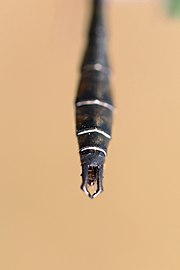| Somatochlora septentrionalis | |
|---|---|

| |
| male | |
| Conservation status | |
 Least Concern (IUCN 3.1) | |
 Secure (NatureServe) | |
| Scientific classification | |
| Domain: | Eukaryota |
| Kingdom: | Animalia |
| Phylum: | Arthropoda |
| Class: | Insecta |
| Order: | Odonata |
| Infraorder: | Anisoptera |
| Family: | Corduliidae |
| Genus: | Somatochlora |
| Species: | S. septentrionalis |
| Binomial name | |
| Somatochlora septentrionalis (Hagen, 1861) | |
| Synonyms | |
| |
Somatochlora septentrionalis, the muskeg emerald, is a species of dragonfly in the family Corduliidae. It is endemic to Canada, where it is found from Yukon and British Columbia east to Nova Scotia and Newfoundland.
Description
Adult muskeg emeralds are 39–48 mm (1.5–1.9 in) long. The body is metallic green, brown and black, with a faint yellow spot on the thorax. This species is identical to Whitehouse's emerald (Somatochlora whitehousei) except in the shape of the male cerci and the female subgenital plate.
-
 female
female
-
 male cerci
male cerci
Life History
Muskeg emeralds occur in open fens with pools of open water. Males patrol over the pools, and females lay eggs by tapping in the open water and in floating vegetation. Adults fly from June to August.
References
- Paulson, D.R. (2017). "Somatochlora septentrionalis". IUCN Red List of Threatened Species. 2017: e.T50978905A65836334. doi:10.2305/IUCN.UK.2017-3.RLTS.T50978905A65836334.en. Retrieved 29 August 2024.
- ^ "Somatochlora septentrionalis". NatureServe Explorer. NatureServe. Retrieved 26 February 2020.
- Paulson, D.; Schorr, M.; Abbott, J.; Bota-Sierra, C.; Deliry, C.; Dijkstra, K.-D.; Lozano, F. (2024). "World Odonata List". OdonataCentral, University of Alabama.
- ^ Paulson, Dennis (2011). Dragonflies and Damselflies of the East. Princeton, New Jersey: Princeton University Press. pp. 351–352.
| Taxon identifiers | |
|---|---|
| Somatochlora septentrionalis | |